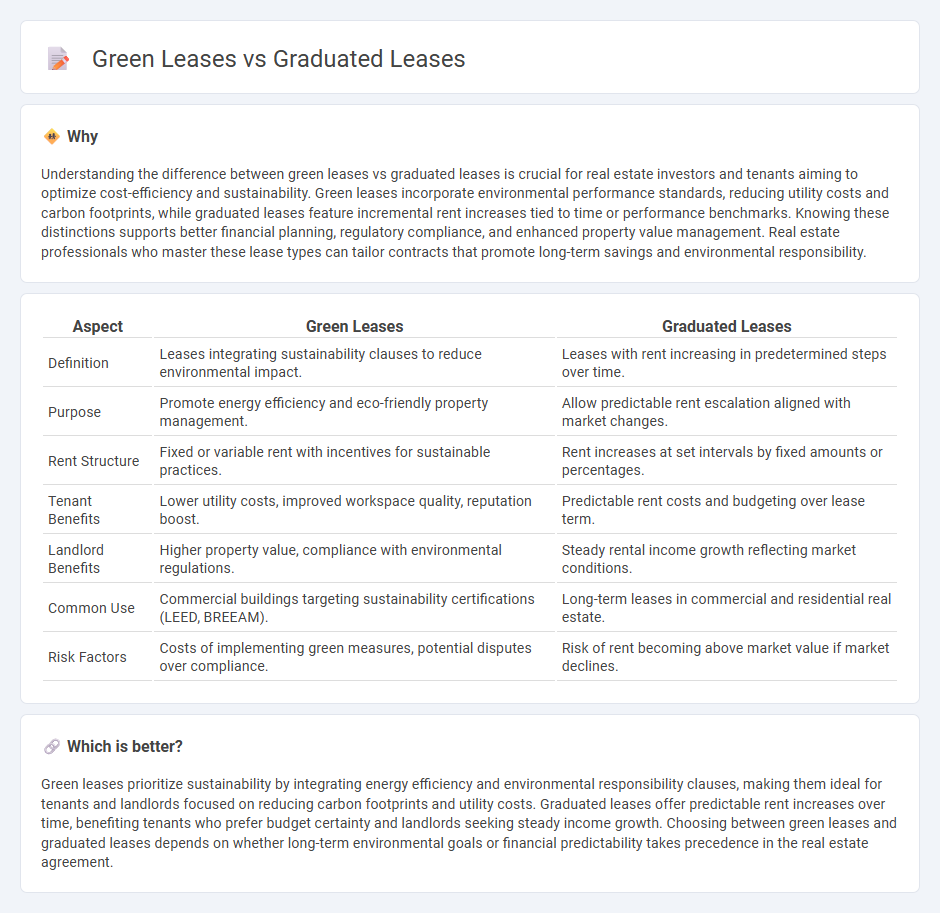
Green leases promote sustainable building practices by incorporating energy efficiency and environmental responsibility clauses into rental agreements, reducing operational costs and carbon footprints. Graduated leases feature predetermined rent increases over time, offering predictable rent escalations aligned with market trends or inflation. Discover the advantages and applications of both lease types to optimize property management strategies.
Why it is important
Understanding the difference between green leases vs graduated leases is crucial for real estate investors and tenants aiming to optimize cost-efficiency and sustainability. Green leases incorporate environmental performance standards, reducing utility costs and carbon footprints, while graduated leases feature incremental rent increases tied to time or performance benchmarks. Knowing these distinctions supports better financial planning, regulatory compliance, and enhanced property value management. Real estate professionals who master these lease types can tailor contracts that promote long-term savings and environmental responsibility.
Comparison Table
| Aspect | Green Leases | Graduated Leases |
|---|---|---|
| Definition | Leases integrating sustainability clauses to reduce environmental impact. | Leases with rent increasing in predetermined steps over time. |
| Purpose | Promote energy efficiency and eco-friendly property management. | Allow predictable rent escalation aligned with market changes. |
| Rent Structure | Fixed or variable rent with incentives for sustainable practices. | Rent increases at set intervals by fixed amounts or percentages. |
| Tenant Benefits | Lower utility costs, improved workspace quality, reputation boost. | Predictable rent costs and budgeting over lease term. |
| Landlord Benefits | Higher property value, compliance with environmental regulations. | Steady rental income growth reflecting market conditions. |
| Common Use | Commercial buildings targeting sustainability certifications (LEED, BREEAM). | Long-term leases in commercial and residential real estate. |
| Risk Factors | Costs of implementing green measures, potential disputes over compliance. | Risk of rent becoming above market value if market declines. |
Which is better?
Green leases prioritize sustainability by integrating energy efficiency and environmental responsibility clauses, making them ideal for tenants and landlords focused on reducing carbon footprints and utility costs. Graduated leases offer predictable rent increases over time, benefiting tenants who prefer budget certainty and landlords seeking steady income growth. Choosing between green leases and graduated leases depends on whether long-term environmental goals or financial predictability takes precedence in the real estate agreement.
Connection
Green leases and graduated leases intersect by integrating sustainability with financial incentives in real estate agreements. Green leases promote environmentally friendly property management, while graduated leases adjust rent based on predefined criteria, such as energy savings or performance benchmarks. Combining these lease types encourages tenants to adopt sustainable practices through financial rewards tied to measurable environmental improvements.
Key Terms
Rent Escalation
Graduated leases feature rent escalation through predetermined periodic increases based on a fixed schedule, providing predictable cost adjustments for tenants over time. Green leases incorporate rent escalation clauses tied to sustainability performance metrics, encouraging energy efficiency and reduced environmental impact within leased properties. Explore how these rent escalation strategies influence tenant expenses and environmental outcomes.
Sustainability Clauses
Graduated leases feature rent increases over time, motivating tenants to enhance property value, whereas green leases incorporate sustainability clauses that mandate energy efficiency, waste reduction, and environmentally responsible practices. Sustainability clauses in green leases align landlord and tenant incentives to reduce carbon footprints and comply with evolving environmental regulations. Explore how integrating sustainability clauses in lease agreements can drive long-term environmental and economic benefits.
Operating Expenses
Graduated leases involve predefined, incremental increases in rent over the lease term, often accounting for rising operating expenses, whereas green leases incorporate sustainability clauses aimed at reducing energy, water, and waste costs through shared responsibilities. Operating expenses in green leases are typically managed via collaborative efforts to implement energy-efficient technologies and sustainable practices, resulting in long-term cost savings. Explore the benefits and cost structures of both lease types to optimize your property management strategy.
Source and External Links
Graduated Lease: What is it? How They Work, Considerations - This webpage provides an overview of graduated leases, explaining how they work with incremental rent increases and their benefits for both landlords and tenants.
Graduated Lease Essentials - This article offers a comprehensive guide to graduated leases, discussing their definition, historical context, and role in modern real estate, particularly in commercial settings.
What Is a Graduated Lease? - This webpage explains that a graduated lease is a commercial lease where rent periodically increases based on stipulated conditions, often tied to indices or property value.
 dowidth.com
dowidth.com